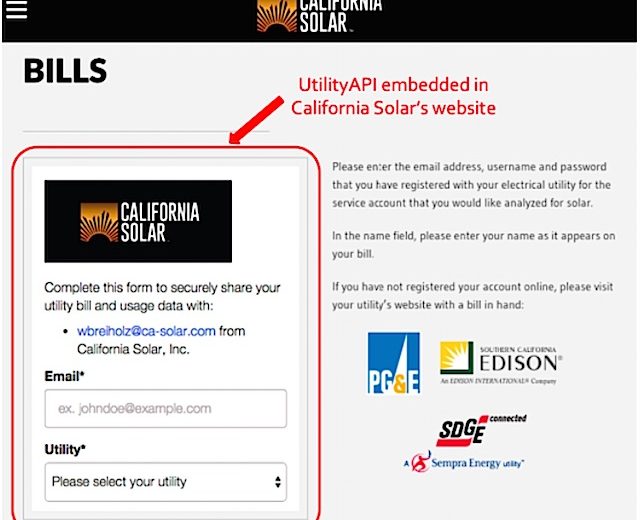Startup Makes it Easy to Get Kilowatt Hours for Solar

Have trouble finding how many kilowatt hours you use? Here’s an easy way:
When you decide to go solar you need to know how many kilowatt hours of electricity you use, but finding out can be unnecessarily difficult. Do you fancy spending hours in phone mail jail trying to get through to customer service (what customer service?) at your electricity provider to get this info?
Getting usage data from your utility is a seemingly simple task, but one that is currently needlessly arduous.
Sometimes it just seems as if it’s more trouble than its worth to switch away from your electric company, to go solar (hmm… I wonder why?)
So; clearly, this is an obvious market need – now filled.
A startup called UtilityAPI has automated the process, so that would-be solar customers can simply fill in a few boxes on an online portal, that cuts through the bureaucracy involved.
There’s an App for that
Now you just click and OK the solar company to simply access the data from your utility; how many kilowatt hours you used each month and when, over the last two years.
Not only is it very cumbersome for you to access this data, but it has long been one of the bureaucratic tasks that makes life difficult for solar firms too.
Even when they try to do it, that involves a lot of phone calls, authorization forms, and then weeks of waiting periods, that currently adds needless time and expense for the solar firm, too.
“Solar companies currently have to do, literally, a three-way phone call” with the would-be residential customer, solar rep and utility call center operator, to get permission to get the data in the installer’s hands,” CEO Elena Lucas told Greentechmedia at this year’s Cleantech Forum in San Francisco.
“It really mucks up the sales process, the relationship you have with the customer,” she said. “We try and take care of that beforehand.”
Solar-friendly format
Once the data enters her software, it is then automatically converted from the various unique formats of each different utility into the formats that solar companies need it in.
The software collects and correctly reformats the different data streams from residential and commercial utility customers so these are usable by the solar consultant in designing a system to suit that customer’s usage profile, whether commercial or residential.
For example, in California, residential customers pay by the tier (paying more per kilowatt hour if they use more kilowatt hours) but commercial customers pay time-of-use rates as well as demand charges (for example, when powering up heavy machinery, there is a one time surge of power needed. This demand use can be as much as half a commercial customer’s bill.)
And so, as well as the by-the-kilowatt hour data, she extracts the breakdown of the tiered rates that the particular customer has been paying, and for commercial or time-of-use customers, determines when their greatest usage is, which helps in orienting a system.
If you pay by time of use, and your highest usage is from four to six o’clock in the afternoon, for example, your solar consultant might suggest that you orient your solar array to be more western facing than simple south-facing.
So far, the three big California utilities are integrated in her system, and seven more will be connected in by the end of the year. But actually; most people who have gone solar in the US are customers of these three; Pacific Gas & Electric, Southern California Edison and San Diego Gas & Electric.
But next stop, the world!
An idea whose time has come.
Image Credit: UtilityAPI
